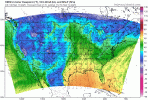jiharris0220
Member
The hrrr has the most realistic depiction of the storm mode on Saturday, it’s in between the fv3 fully discrete mode dooms day scenario and the NAMs linear qlcs system.
The dry line has a semi discrete to linear storm mode and the OWS has a fully discrete mode. And as expected, the UH tracks also fall in between the fv3 and Nam in severity.
The dry line has a semi discrete to linear storm mode and the OWS has a fully discrete mode. And as expected, the UH tracks also fall in between the fv3 and Nam in severity.


